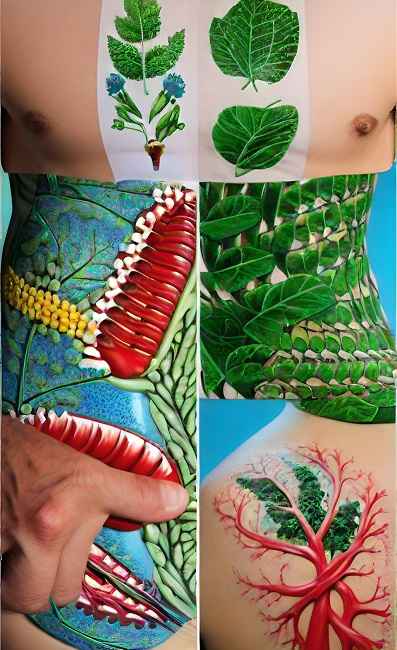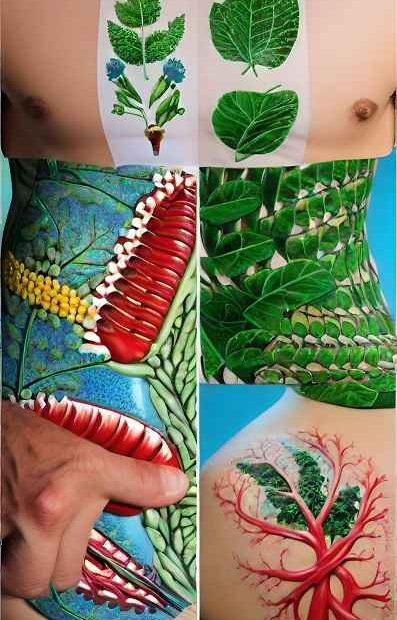The human body is a remarkable machine that can heal itself from various injuries and illnesses. However, not all parts of the body heal at the same rate. Some parts of the body have a faster healing process than others, depending on factors such as blood supply, oxygenation, nutrition, infection, and movement.
In this article, we will explore the top 10 fastest healing body parts and explain why they heal so quickly. We will also provide some tips on how to speed up the healing process and prevent complications.

1. Mouth and Gums
The mouth and gums are among the fastest healing parts of the body due to the rich blood supply in the area. The blood vessels deliver oxygen and nutrients to the cells and remove waste products and bacteria. The mouth also produces saliva, which has antibacterial and anti-inflammatory properties that help prevent infection and promote healing.
The mouth and gums can heal from minor cuts, scrapes, burns, and ulcers in a matter of days. However, some conditions such as gingivitis, periodontitis, oral cancer, and dry mouth can slow down the healing process and cause complications. Therefore, it is important to maintain good oral hygiene, avoid tobacco and alcohol, eat a balanced diet, drink plenty of water, and visit your dentist regularly.
2. Fingertips
Fingertips have a high concentration of nerve endings and a robust blood supply, allowing them to heal relatively quickly. Fingertips can regenerate from minor injuries such as cuts, burns, blisters, and nail damage in a few weeks. However, if the injury is severe enough to damage the bone or the nail bed, it may take longer to heal and require medical attention.
To speed up the healing process of your fingertips, you should keep them clean and dry, apply pressure to stop bleeding, cover them with a sterile bandage or dressing, elevate them above your heart level, and avoid touching or picking at them. You should also avoid exposing them to extreme temperatures or chemicals that may irritate or infect them.
3. Shallow Wounds on the Skin
Surface-level cuts or scrapes on the skin heal rapidly because they involve only the epidermis, which is the outermost layer of the skin. The epidermis has a high turnover rate of cells that constantly replace themselves. The skin also has a natural barrier function that protects it from infection and dehydration.
Shallow wounds on the skin can heal in a few days to a week with proper care. You should wash them with soap and water, apply an antibiotic ointment or cream, cover them with a bandage or dressing, change them daily, and monitor them for signs of infection such as redness, swelling, pain, pus, or fever.
4. Cornea
The cornea is the transparent layer that covers the front of the eye. It is responsible for refracting light and focusing vision. The cornea is the only part of the human body that has no blood supply; it gets oxygen directly through the air. The cornea is also one of the fastest healing tissues in the human body; it can heal from minor abrasions or scratches in as little as 24 to 36 hours.
However, if the cornea is damaged by deeper injuries such as chemical burns, infections, or ulcers, it may take longer to heal and cause permanent vision loss. Therefore, it is essential to protect your eyes from foreign objects, chemicals, UV rays, and infections by wearing sunglasses, goggles, contact lenses, or eye drops as needed. You should also seek immediate medical attention if you experience any eye pain, redness, sensitivity to light, blurred vision, or discharge.
5. Upper Torso
The upper torso includes the chest, back, shoulders, arms, and neck. These areas have a faster healing process than other parts of the body because they have more muscle mass and less fat tissue. Muscle tissue has a higher metabolic rate than fat tissue; it consumes more oxygen and nutrients and produces more waste products. This means that muscle tissue can repair itself faster than fat tissue.
The upper torso can heal from minor injuries such as bruises, sprains, strains, and fractures in a few weeks to months with proper treatment. You should rest, ice, compress, and elevate the injured area, take anti-inflammatory medications, and follow your doctor’s instructions. You should also avoid strenuous activities that may aggravate the injury or cause further damage.
6. Face
The face is another fast-healing part of the body because it has a high density of blood vessels and nerve endings. The blood vessels provide the face with ample oxygen and nutrients and remove waste products and bacteria. The nerve endings stimulate the healing process by sending signals to the brain and the immune system.
The face can heal from minor injuries such as cuts, burns, bites, and acne in a few days to weeks with proper care. You should cleanse the wound with mild soap and water, apply an antibiotic ointment or cream, cover it with a bandage or dressing, change it daily, and monitor it for signs of infection. You should also avoid touching or picking at the wound, exposing it to sunlight or heat, or applying makeup or cosmetics that may irritate or infect it.
7. Hair and Nails
Hair and nails are made of keratin, a protein that forms the outer layer of the skin, hair, and nails. Keratin is a durable and resilient substance that can withstand damage and stress. Hair and nails grow continuously from the root, which is located under the skin. The root receives blood supply from the capillaries, which deliver oxygen and nutrients to the cells.
Hair and nails can heal from minor damage such as split ends, breakage, chipping, or peeling in a few weeks to months with proper care. You should trim your hair and nails regularly, moisturize them with oils or creams, protect them from heat, chemicals, or infections, and eat a balanced diet rich in protein, iron, zinc, biotin, and other vitamins and minerals.
8. Liver
The liver is the largest internal organ in the human body. It performs various vital functions such as filtering blood, producing bile, metabolizing drugs and toxins, storing glycogen, synthesizing proteins, and regulating hormones. The liver is also one of the most regenerative organs in the human body; it can heal from minor injuries or diseases in a few weeks to months by replacing damaged cells with new ones.
However, if the liver is damaged by chronic conditions such as hepatitis, cirrhosis, fatty liver disease, or cancer, it may lose its ability to regenerate and cause serious complications. Therefore, it is important to protect your liver from harm by avoiding alcohol, tobacco, drugs, and toxins, eating a healthy diet low in fat and sugar, exercising regularly, and getting vaccinated against hepatitis.
9. Bones
Bones are the rigid structures that form the skeleton of the human body. They support the body’s weight, protect the internal organs, enable movement, and produce blood cells. Bones are composed of collagen, a protein that provides flexibility and strength, and calcium phosphate, a mineral that provides hardness and stability. Bones have a remarkable ability to heal from fractures or breaks by forming new bone tissue around the injured site.
However, bone healing is a complex and slow process that depends on several factors such as age, health status, nutrition, blood supply, infection, and immobilization. Bone healing can take anywhere from six weeks to six months or longer with proper treatment. You should follow your doctor’s advice on how to care for your fracture, such as wearing a cast, splint, or brace, taking painkillers, and doing physical therapy.
10. Brain
The brain is the most complex and vital organ in the human body. It controls all the functions of the body, such as breathing, heartbeat, movement, sensation, thought, memory, emotion, and behavior. The brain is made up of billions of neurons, which are specialized cells that communicate with each other through electrical and chemical signals. The brain has some capacity to heal from minor injuries or diseases by creating new connections between neurons or activating dormant neurons.
However, the brain has limited ability to regenerate new neurons or replace lost ones. Therefore, brain damage caused by severe injuries or diseases such as stroke, traumatic brain injury, Alzheimer’s disease, or Parkinson’s disease can have permanent and devastating effects on cognitive, emotional, and physical functions. To prevent or minimize brain damage, you should protect your head from injury by wearing a helmet or seatbelt when appropriate, avoid alcohol, tobacco, drugs, and toxins that may impair brain function, eat a balanced diet rich in antioxidants and omega-3 fatty acids that may protect brain cells from oxidative stress and inflammation, exercise regularly to improve blood flow and oxygen delivery to the brain, and stimulate your brain with mental activities such as reading, learning, puzzles, or games.
Conclusion
The human body has an amazing ability to heal itself from various injuries and illnesses. However, some parts of the body heal faster than others depending on factors such as blood supply, oxygenation, nutrition, infection, and movement. In this article, we have listed the top 10 fastest healing body parts and explained why they heal so quickly. We have also provided some tips on how to speed up the healing process and prevent complications.
We hope you have found this article informative and helpful. If you have any questions or comments about this topic or any other
